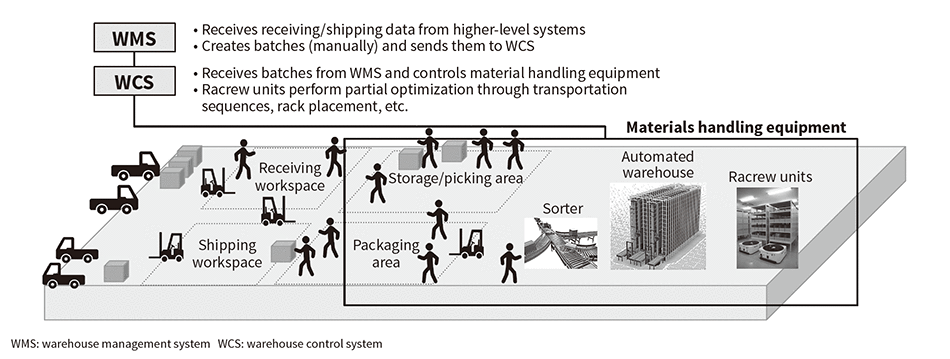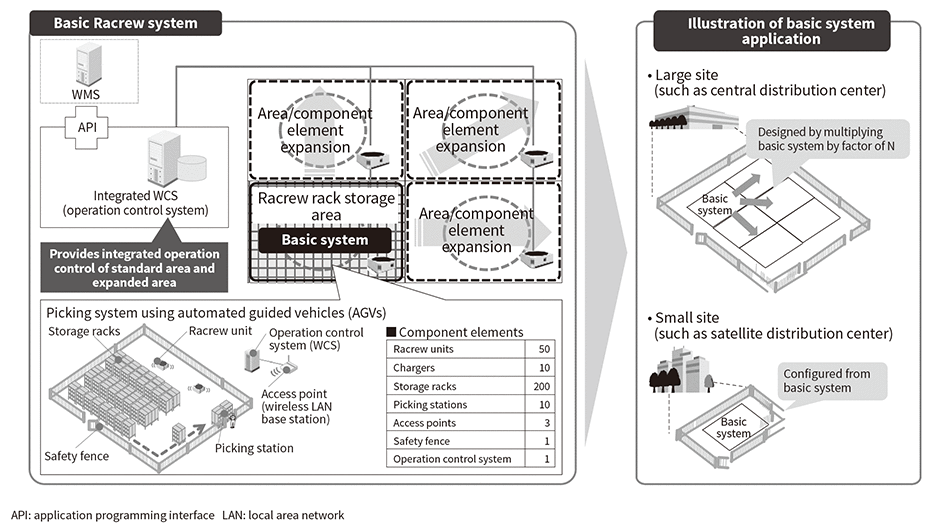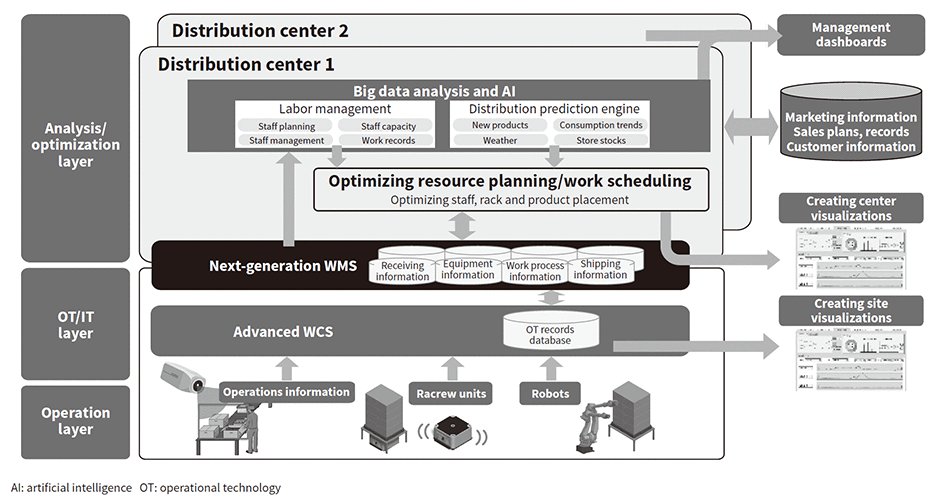Core Utility Products Underpinning the Social InfrastructureLogistics Solutions for Greater Efficiency
Highlight
Finding the capacity to rapidly ship large product volumes and dealing with staff shortages that impede capacity are some of the biggest issues facing distribution centers. To respond to the increasing site workloads caused by these issues, Hitachi is working on digital solutions driven by the Internet of Things, big data analysis, artificial intelligence, and other cutting-edge technologies, while also working on distribution center refinements made possible by products such as picking systems using automated guided vehicles. This article presents Hitachi’s work and the future outlook for these areas.

1. Introduction
Distribution centers need to rapidly and accurately handle the work needed to ship products as specified in a wide range of orders representing a massive inventory of products. Since this work starts after the order is finalized, it does not enable advance preparation and needs to be made more efficient.
While the manual labor needed for some work processes is being reduced by installing materials handling equipment, many work processes still rely on manual labor. And, with worker shortages becoming increasingly severe, saving labor and improving work efficiency are urgent issues(1), (2), (3). To respond to these issues, distribution centers will need to save labor by installing robots and boost efficiency by analyzing and using work data. Researchers are looking at various approaches for handling busy workloads at sites. Digital solutions such as the Internet of Things (IoT) and artificial intelligence (AI) can also be used in addition to work data and robots to increase the efficiency of the entire supply chain encompassing multiple centers.
This article looks at next-generation logistics, presenting Hitachi’s overall vision of distribution centers and supply chains.
2. Products for Distribution Centers
2.1 Picking Systems Using Automated Guided Vehicles
Fig. 1—Current Distribution Center Configuration A distribution center is composed of a central storage/picking area and elements such as a receiving workspace, packaging area, and shipping workspace.
A distribution center is composed of a central storage/picking area and elements such as a receiving workspace, packaging area, and shipping workspace.
Fig. 2—Racrew Units and Storage Racks The photo shows Racrew units and storage racks. The table below it gives their specifications.
The photo shows Racrew units and storage racks. The table below it gives their specifications.
A conventional distribution center is composed of a receiving workspace, storage/picking area, packaging area, and shipping workspace (see Figure 1). Automated warehouse equipment, conveyors, sorters, and other materials handling equipment is installed in the storage/picking area. Picking work done to gather the required products from warehouse racks or the automated warehouse is a crucial part of the shipping process.
Picking is usually done by workers called pickers who walk through the warehouse gathering products by referring to a printed list or terminal. The walking time accounts for the majority of this work. It has a high physical workload and has always been unsuited to efficiency improvements. To improve picking work efficiency, Hitachi has solved the problems of picking work by developing a compact automated guided vehicle (AGV) called Racrew to create a picking system using AGVs (see Figure 2). Racrew units take over for workers in transporting product storage racks to workspaces called picking stations. They greatly reduce worker walking time and travel distance as a result, enabling a major reduction in physical workload. Since they leave workers free to focus on picking, they have roughly tripled work efficiency relative to the conventional picking method. Displaying the required product information on equipment such as a digital picking system (DPS) or terminal also provides other benefits. It allows even inexperienced workers to work fairly efficiently, and greatly reduces the error rate for gathered products.
2.2 Dealing with Expanding System Size
Fig. 3—Basic Racrew System and System Expansion A basic Racrew system has about 50 Racrew units and about 10 picking stations. Large systems can also be supported by connecting multiple basic systems together in parallel.
A basic Racrew system has about 50 Racrew units and about 10 picking stations. Large systems can also be supported by connecting multiple basic systems together in parallel.
The size of a Racrew-based picking system is determined by the quantity of products handled. The basic system is composed of about 50 Racrew units, about 10 picking stations with conveyor systems upstream and downstream from them, an automated warehouse, and a warehouse control system (WCS) that controls the other system elements. To handle work processes efficiently, the WCS controls the delivery sequence, rack transportation sequence and picking sequence. The WCS operates under a warehouse management system (WMS) that manages the entire distribution center. There is a data connection between the two systems.
Large systems can be supported by connecting the systems above in parallel (see Figure 3). One system in Japan has 250 Racrew units connected as six parallel systems and operated with an automated warehouse and conveyor line(4), (5). It can flexibly adapt to the growth in center size being anticipated.
2.3 Advanced WCS Systems Connected to Next-generation WMS Systems
Fig. 4—Connecting a Next-generation WMS and Advanced WCS Various types of information about distribution and operations inside the distribution center are stored on a database to bring visibility to the site. Resource planning, work scheduling, and the center itself can be optimized by connecting the data to a next-generation WMS and using it with digital solutions such as big data analysis and AI.
Various types of information about distribution and operations inside the distribution center are stored on a database to bring visibility to the site. Resource planning, work scheduling, and the center itself can be optimized by connecting the data to a next-generation WMS and using it with digital solutions such as big data analysis and AI.
In addition to distribution data from within the distribution center, the WCS also gathers site operational technology (OT) data such as information about Racrew/automated warehouse processes and terminal operations. This data is gathered and stored in a database to increase its added value. Tactical site data handled by the WCS is sent to the WMS. It is evaluated in reference to strategic data about the entire distribution center, enabling uses such as center optimization planning. The use of AI solutions provided by Hitachi could enable automation of tasks that have so far depended on the expertise of experienced workers. Examples include predicting seasonal or event-driven quantity changes and studying placement. A strategic approach to supply chain management (SCM) spanning multiple business units could also be possible by gathering data from several different distribution centers and using a big data analysis solution to create a dashboard designed for management strategies (see Figure 4).
With these sorts of applications in mind, Hitachi is now working on creating WCS systems and databases that support higher-level connection. The company will provide high added-value systems by identifying continuously changing site conditions, extracting issues and providing data connections to higher-level systems.
2.4 Using Dashboards to Create Site Visualizations
Fig. 5—Creating Site Visualizations Using Dashboards Bringing visibility to current site conditions lets sites see the progress of work processes, and dynamically review work priority levels or staff placement.
Bringing visibility to current site conditions lets sites see the progress of work processes, and dynamically review work priority levels or staff placement.
Analyzing the site OT data handled by the WCS enables tactical approaches to site work efficiency improvements and materials handling equipment maintenance work. Hitachi is currently aiming to bring visibility to sites by aggregating this data in dashboard displays. Data about materials handling equipment processes and worker operations that is stored in a database can be aggregated and visualized for site managers and workers. It lets them see the daily work progress, and dynamically review work priority levels or staff placement. Studying the different data sets in comparison to each other will be an effective way to improve site operation. Operation data acquired from equipment will also enable planned maintenance (see Figure 5).
3. Next-generation Logistics
Fig. 6—Future Distribution Center Configuration Hitachi is studying the use of Racrew units for transportation centered around the picking system, during the processes upstream and downstream from picking. The company also wants to create futuristic distribution centers by adding robots.
Hitachi is studying the use of Racrew units for transportation centered around the picking system, during the processes upstream and downstream from picking. The company also wants to create futuristic distribution centers by adding robots.
As mentioned above, today’s shrinking workforce is a problem that has also affected distribution centers by creating worker shortages. Hitachi is continuing to research labor-saving approaches that use robots for work previously done by humans, and is continuing to develop robot-based product picking methods for picking work.
Sites (distribution centers) also need to work on labor-saving approaches for processes upstream and downstream from picking work. Among the upstream processes before picking work (preprocesses), examples include product replacement work and placement changes in response to demand trends. Among downstream processes after picking work (postprocesses), examples include grouping each product that has finished the picking process by shipment destination, and automating the processes from inspection, packaging, and transportation to shipping. Today’s materials handling equipment can use an automated warehouse to group products by shipment destination, and can use conveyors and sorters for transportation. But, since the equipment itself takes up more space in these systems, they end up having less flexibility for handling future line changes or the like. Hitachi is looking into also using Racrew units for product replacement (among preprocesses) and for transportation between processes (among postprocesses). Hitachi’s aim is to eventually create labor-saving distribution centers made possible by using Racrew units to provide systems that can handle line changes in a highly flexible manner, and by combining these systems with robots (see Figure 6).
4. Conclusions
This article has looked at the work being done on Hitachi solutions and products for creating more advanced distribution centers, along with the future outlook for this area.
Distribution is an increasingly important social infrastructure. To create highly labor-saving distribution centers with high handling capacities, Hitachi is bringing together its full range of abilities as it works on solving challenges through collaborative creation with customers.
REFERENCES
- 1)
- K. Moritsuna et al., “Streamlined Picking Operations Using Racrew: Compact Automated Guided Vehicle—A Solution to Innovate Distribution Sites―,” Hitachi Hyoron, 96, pp. 778–781 (Dec. 2014) in Japanese.
- 2)
- “Logistics Innovations behind the Convenience of e-Commerce,” Hitachi Review, 67, pp. 166–171 (Feb. 2018).
- 3)
- A. Ikeda et al., “Enhancing Distribution Centers Using Robotics and Digital Solution Technologies,” Hitachi Review, 67, pp. 239–244 (Feb. 2018).
- 4)
- Hitachi, Ltd., “Customers Getting What They Want, When They Want It: Automated Guided Vehicles Support the e-Commerce Industry,” (Jan. 2018).
- 5)
- Hitachi Industrial Products, Ltd., “Racrew: Compact Automated Guided Vehicle,” (Apr. 2019), in Japanese.





